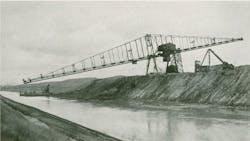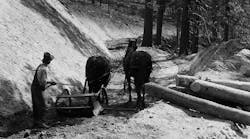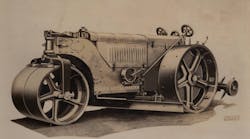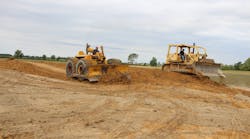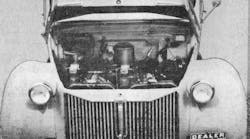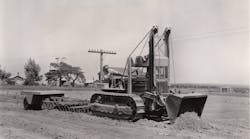Brown Hoisting & Conveying Machinery Co. was founded in Cleveland, Ohio, by Fayette Brown and his son, Alexander Ephraim Brown, in 1880. The firm was incorporated in 1893, and by 1900 had been renamed Brown Hoisting Machinery Co.
Alexander E. Brown, a mechanical engineer and bridge builder, had committed himself to developing a better technology for unloading iron ore from Great Lakes freighters. Since the inception of ore shipments in 1855, the ore had been unloaded manually. At first, laborers shoveled the ore up a multiple-decked scaffold from the top of the pile to the ship’s deck, then into wheelbarrows that were pushed to the dock on a gangplank. The only major improvement until 1880 was to replace the scaffold with a derrick that lifted skips, still loaded by hand, to the deck where shovelers transferred the contents to the wheelbarrows.
The Historical Construction Equipment Association (HCEA) is a 501(c)3 nonprofit organization dedicated to preserving the history of the construction, dredging and surface mining equipment industries. With more than 4,000 members in 25 countries, activities include operation of National Construction Equipment Museum and archives in Bowling Green, Ohio; publication of a quarterly magazine, Equipment Echoes, from which this text is adapted, and hosting an annual working exhibition of restored construction equipment. Individual memberships are $32 within the U.S. and Canada, and $40 elsewhere. Information: 419.352.5616 or [email protected].
Brown revolutionized bulk cargo unloading in 1880 with a cable tramway that carried the skips from the hold to the stockpile or a waiting railroad car. A cableway and self-loading skips that resembled dragline buckets followed; then, under the trade name Brownhoist, he developed the first clamshell type unloader, with a 1 1/2-ton bucket suspended from a traveling bridge crane. Circa 1900, an estimated 75 percent of ore shipped on the Great Lakes was being handled by Brownhoist equipment. Brown even developed the world’s first wheel loader, the Power Scraper Shovel; it was designed to gather cargo from between the hatches and out of the hold’s corners and place it within reach of the unloader.
When conventional means of removing shot rock from the floor to the banks of the Chicago Drainage Canal proved uneconomical at $1.75 per cubic yard, several contractors approached Brownhoist for a solution. The result was the world’s first cantilever, or hammerhead, crane. Introduced in 1893, 11 of these cranes did the job for one-third that amount. They were resold for other uses after the project was finished, and one of them was later adapted as a dragline for construction of the New York Barge Canal. No other applications of these machines for excavation are known at this time, but mobile hammerhead cranes of various makes are known to have placed concrete at Grand Coulee, Friant and Folsom dams in the 1930s through 1950s, and hammerhead tower cranes are widely used today.
Brownhoist also manufactured bridge, gantry, Portal-Pier (or whirley), and locomotive cranes; clamshell and dragline buckets; and a wide range of equipment designed specifically for steel production and industrial material handling. It entered the full-revolving cable excavator market circa 1923, and although such machines were only a minor part of Brownhoist’s overall production, the full-revolving excavator had rapidly rendered cantilever cranes obsolete for construction excavation.
In 1927, Brown Hoisting Machinery merged with a similar firm, Industrial Works of Bay City, Mich., and a new company, Industrial Brownhoist Corp., was established with headquarters in Bay City. By 1950, Industrial Brownhoist boasted it had built “more than 20,000 cranes of all types,” but construction excavators appear to have been just a sideline that played a relatively minor part of their total business.
Business fell off after World War II, and Industrial Brownhoist was sold to Penn-Texas Corp. in 1954; five years later it was sold again, to a hotel group based in Miami Beach, Fla. Business continued to fade, and in 1960 American Hoist & Derrick Co. of St. Paul, Minn., purchased what remained: a plant with only about 40 employees. Its new life as American’s Industrial Brownhoist Division reinvigorated the plant for a couple of decades before it was shut down for good in 1983.
